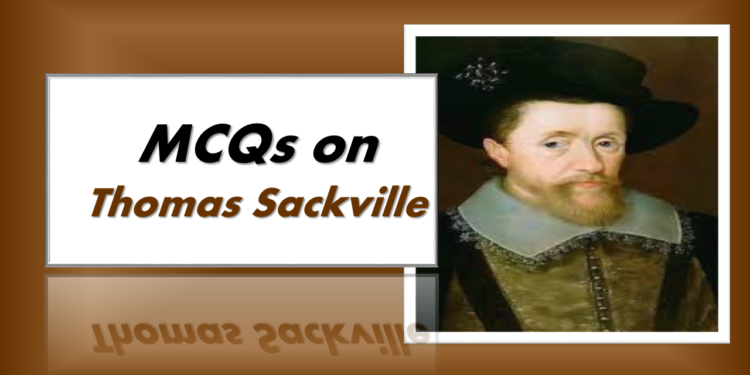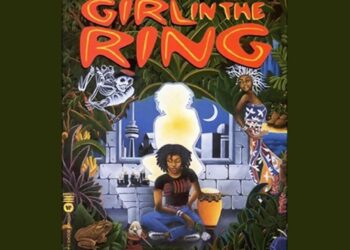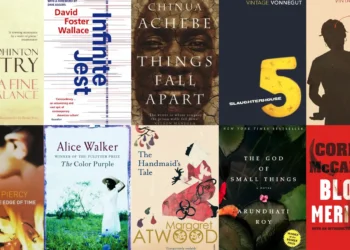MCQs on Thomas Sackville
MCQs on Thomas Sackville-For what is Sackville noted?,What is the induction by Thomas Sackville?,thomas sackville famous works,thomas sackville induction,MCQs on Thomas Sackville
1. In which century did Thomas Sackville live?
a) 15th
b) 16th
c) 17th
d) 18th
2. Thomas Sackville was a prominent figure during the:
a) Renaissance
b) Middle Ages
c) Enlightenment
d) Romantic Period
3. Sackville is best known for his collaboration on:
a) “The Canterbury Tales”
b) “The Faerie Queene”
c) “Gorboduc”
d) “Arcadia”
4. What was Sackville’s title and position in the English court?
a) Earl of Leicester, Secretary of State
b) Duke of Norfolk, Lord Chamberlain
c) Baron Burghley, Lord Chancellor
d) Earl of Dorset, Lord Admiral
5. Sackville’s most famous work is a tragedy written in blank verse titled:
a) “Tamburlaine”
b) “Doctor Faustus”
c) “Gorboduc”
d) “The Spanish Tragedy”
6. Sackville served as Lord Chancellor during the reign of:
a) Henry VIII
b) Elizabeth I
c) James I
d) Charles I
7. Sackville was a co-author of the first English blank verse tragedy, which is:
a) “The Tragical History of Doctor Faustus”
b) “Gorboduc”
c) “The Spanish Tragedy”
d) “Tamburlaine”
8. Sackville’s major contribution to “Gorboduc” is in collaboration with:
a) Christopher Marlowe
b) Philip Sidney
c) Thomas Kyd
d) Thomas Norton
9. Sackville was a member of the literary group known as:
a) The Metaphysical Poets
b) The Cavaliers
c) The Sons of Ben
d) The Spenserians
10. In addition to his literary pursuits, Sackville was involved in:
a) Alchemy
b) Astronomy
c) Music composition
d) Courtly fashion
11. Sackville’s “Gorboduc” is also known by the title:
a) “The Spanish Tragedy”
b) “The Tragical History of Doctor Faustus”
c) “The Mirror for Magistrates”
d) “Ferrex and Porrex”MCQs on Thomas Sackville
12. Sackville’s collaboration with Thomas Norton in “Gorboduc” was intended to:
a) Please Queen Elizabeth I
b) Entertain the court
c) Advocate for political reforms
d) Explore classical mythology
13. Sackville’s “The Complaint of Henry, Duke of Buckingham” is an example of:
a) A pastoral poem
b) A revenge tragedy
c) An epic poem
d) A political allegory
14. Sackville was a member of which political faction during his time?
a) Cavaliers
b) Roundheads
c) Tudor loyalists
d) Yorkists
15. Sackville’s political career included serving as:
a) Secretary of State
b) Lord Admiral
c) Lord Chamberlain
d) Lord Protector
16. Sackville was involved in the development of the first English:
a) Novel
b) Blank verse drama
c) Sonnet sequence
d) Allegorical poem
17. Sackville’s “A Complaint of a Lover’s Life” is written in the form of:
a) A sonnet sequence
b) A pastoral elegy
c) A dramatic monologue
d) A satirical essay
18. Sackville’s contribution to “The Mirror for Magistrates” includes:
a) Writing the entire work
b) Editing and compiling the work
c) Providing illustrations
d) Funding the publication
19. Sackville’s historical play “Gorboduc” is also known for:
a) Introducing the use of rhymed couplets
b) Popularizing the use of iambic pentameter
c) Experimenting with the use of prose
d) Incorporating classical mythology
20. Sackville’s role in “The Mirror for Magistrates” is to:
a) Narrate the frame story
b) Contribute individual tragic narratives
c) Write the introductory poem
d) Illustrate the characters
Also Read-
MCQs on Edmund Spenser
MCQs on Thomas Elyot
MCQs on William Dunbar
21. Sackville was associated with which literary movement?
a) Romanticism
b) Humanism
c) Enlightenment
d) Realism
22. Sackville’s “The Complaint of Henry, Duke of Buckingham” reflects his views on:
a) Courtly love
b) Political ambition
c) Religious reformMCQs on Thomas Sackville
d) Chivalry
23. Sackville’s literary works were influenced by:
a) Greek mythology
b) Italian Renaissance literature
c) Chinese poetry
d) Medieval romance
24. Sackville’s contribution to the development of English drama includes:
a) Introducing the use of the chorus
b) Writing the first comedy
c) Experimenting with tragicomedy
d) Establishing the use of the prologue
25. Sackville’s “The Mirror for Magistrates” is a collection of:
a) Essays
b) Sonnets
c) Tragic narratives
d) Satirical poems
26. Sackville’s involvement in “Gorboduc” reflects his interest in:
a) Classical drama
b) Religious morality plays
c) Courtly romances
d) Tragedy of blood
27. Sackville’s historical position in the court was elevated by:
a) Marrying into royalty
b) Military victories
c) Diplomatic achievements
d) Literary accomplishments
28. Sackville’s sonnet sequence, if he had one, is not extant today.
a) True
b) False
29. Sackville’s political career was marred by:
a) Charges of treason
b) Financial scandals
c) Accusations of heresy
d) None of the above
30. Sackville’s “Gorboduc” is notable for its use of:
a) Rhymed couplets
b) Blank verse
c) Prose
d) Terza rima
31. Sackville’s contribution to “The Mirror for Magistrates” reflects the influence of:
a) The Renaissance
b) The Middle Ages
c) Romanticism
d) Classicism
32. Sackville’s historical play “Gorboduc” is set in ancient:
a) Greece
b) Rome
c) Egypt
d) Britain
33. Sackville’s literary style can be described as:
a) Ornate and elaborate
b) Simple and straightforward
c) Abstract and philosophical
d) Satirical and witty
34. Sackville’s role as Lord Chancellor involved:
a) Managing the royal household
b) Overseeing legal matters
c) Leading military campaigns
d) Conducting diplomatic missions
35. Sackville’s “The Complaint of Henry, Duke of Buckingham” is written in the form of:
a) A ballad
b) A sonnet sequence
c) A pastoral elegy
d) A dramatic monologue
36. Sackville’s literary collaboration with Norton in “Gorboduc” aimed to:
a) Advocate for religious tolerance
b) Critique the monarchy
c) Explore the theme of revenge
d) Promote political stability
37. Sackville’s influence can be seen in later works, including:
a) “The Faerie Queene” by Edmund Spenser
b) “Hamlet” by William Shakespeare
c) “Paradise Lost” by John Milton
d) “Don Quixote” by Miguel de Cervantes
38. Sackville’s historical play “Gorboduc” is also known for its use of:
a) Allegory
b) Satire
c) Farce
d) Masque
39. Sackville’s career in politics included a period of exile.
a) True
b) False
40. Sackville’s “The Complaint of Henry, Duke of Buckingham” reflects his disillusionment with:
a) Courtly life
b) Political power
c) Romantic love
d) Military conquest
41. Sackville’s contribution to “The Mirror for Magistrates” is set in the form of:
a) Letters
b) Dialogues
c) Sonnets
d) Monologues
42. Sackville’s political career reached its peak during the reign of:
a) Henry VIII
b) Elizabeth I
c) James I
d) Charles I
43. Sackville’s “The Complaint of Henry, Duke of Buckingham” mourns the fall from:
a) Political power
b) Grace
c) Love
d) Religious faith
44. Sackville’s historical position in the court was primarily due to:
a) Family connections
b) Military prowess
c) Literary achievements
d) Financial wealth
45. Sackville’s “The Complaint of Henry, Duke of Buckingham” is considered a:
a) Pastoral poem
b) Sonnet sequence
c) Satirical piece
d) Elegy
46. Sackville’s “The Mirror for Magistrates” reflects the genre of:
a) Tragedy
b) Comedy
c) Allegory
d) Romance
47. Sackville’s literary works were influenced by the classical writings of:
a) Homer
b) Virgil
c) Ovid
d) All of the above
48. Sackville’s historical play “Gorboduc” is written in:
a) Rhymed couplets
b) Blank verse
c) Prose
d) Terza rima
49. Sackville’s “The Complaint of Henry, Duke of Buckingham” serves as a lament for:
a) Lost love
b) Political power
c) Religious convictions
d) Military victories
50. Sackville’s literary circle included notable figures such as:
a) Christopher Marlowe
b) Philip Sidney
c) Edmund Spenser
d) All of the above
Ansewer
1. b) 16th
2. a) Renaissance
3. c) “Gorboduc”
4. b) Duke of Norfolk, Lord Chamberlain
5. c) “Gorboduc”
6. b) Elizabeth I
7. d) “Tamburlaine”
8. d) Thomas Norton
9. a) The Metaphysical Poets
10. a) Alchemy
11. d) “Ferrex and Porrex”
12. c) Advocate for political reforms
13. a) A pastoral poem
14. d) Yorkists
15. c) Lord Chamberlain
16. b) Blank verse drama
17. c) A dramatic monologue
18. b) Editing and compiling the workMCQs on Thomas Sackville
19. a) Introducing the use of rhymed couplets
20. b) Contribute individual tragic narratives
21. b) Humanism
22. b) Political ambition
23. b) Italian Renaissance literature
24. b) Writing the first comedy
25. c) Tragic narratives
26. a) Classical drama
27. c) Diplomatic achievements
28. a) True
29. d) None of the above
30. b) Blank verse
31. a) The Renaissance
32. b) Rome
33. a) Ornate and elaborate
34. b) Overseeing legal matters
35. c) A pastoral elegy
36. c) Explore the theme of revenge
37. a) “The Faerie Queene” by Edmund Spenser
38. a) Allegory
39. a) True
40. b) Political power
41. d) Monologues
42. b) Elizabeth I
43. b) Grace
44. a) Family connections
45. c) Satirical piece
46. c) Allegory
47. d) All of the above
48. b) Blank verse
49. b) Political power
50. d) All of the above
















